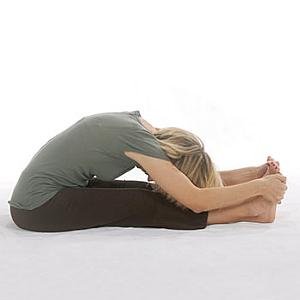 Pashchim, meaning west, here refers to the back, and uttana means stretch. Thus, this is a pose that stretches the back and waist to extreme flexibility with accompanying benefits.
Pashchim, meaning west, here refers to the back, and uttana means stretch. Thus, this is a pose that stretches the back and waist to extreme flexibility with accompanying benefits.
To do this pose, follow these steps:
- Sit straight on the floor keeping legs straight ahead, touching the floor.
- Lifting spine from the hinges of the hips, rather than the waist, lean forward without bending the knees.
- Try to bring the chest forward so that back and waist are stretched, and not to bring the head to the knees which would unduly stress the neck.
A similar pose is Uttanasana which is done in standing position. However, Pashchimottanasana is safer and more effective as it reduces the factor of gravity in the stretch with a corresponding increase in flexibility. Further, in the sitting position the support of arms is also available to the upper body which, with their help, can be moved further or pulled in, as desired.
Another advantage Pashchimottanasana has over Uttanasana is that legs are free to introduce further variations in the pose. Thus, you can rotate them inward or outward; similarly, you can flex the knees and ankles or extend them. These variations can be practiced one after the other at a stretch to exercise different muscle groups on the legs, or to simply divert one’s mind from the lower back and the hamstrings that are being stretched. Used rhythmically, they will also aid in relaxation.
Benefits
- This pose brings flexibility to the spine. Spinal rigidity is a symptom of old age. So, spinal flexibility keeps the springs of youthfulness flowing.
- Relieves a backache and other back problems.
- Corrects all spinal disorders.
- Tones up abdomen, waist, and surrounding muscle groups.
- Cures all kinds of stomach trouble. Especially improves digestion.
- Good for those with low blood pressure.
- Removes disorders of liver, kidneys, intestines, gallbladder, pancreas and spleen.
